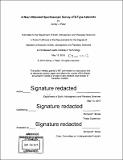A near-ultraviolet spectroscopic survey of B-type asteroids
Author(s)
Peter, Ashley J
DownloadFull printable version (6.481Mb)
Other Contributors
Massachusetts Institute of Technology. Department of Earth, Atmospheric, and Planetary Sciences.
Advisor
Richard P. Binzel.
Terms of use
Metadata
Show full item recordAbstract
This study aimed to evaluate the presence of spectral slope variations of B-type asteroids in the near-ultraviolet wavelength range and further compare variations to those found in the near-infrared (de Leon et al., 2012) and infrared (All-Lagoa et al., 2013). New observations of 19 B-type asteroids were obtained using the Telescopio Nazionale Galileo (TNG) and additional observations were collected on the William Herschel Telescope (WHT) and Isaac Newton Telescope (INT). After identifying appropriate solar analogs for spectral reduction, it was found that 1) not all asteroids are B-types as classified by the M4AST online tool (Popescu et al., 2012), and 2) spectral slope variations were present amongst the B-type asteroids. These spectral slope variations could not be traced to the use of certain solar analogs or differences in airmass during observations. Furthermore, these variations were in good agreement spectral slope variations of carbonaceous chondrites, particularly in the near-UV region. These results support the work of de Leon et al. (2012) and Alf-Lagoa et al. (2013) in identifying spectral slope variations and contributing to a three-part survey of B-type asteroids across different wavelengths.
Description
Thesis: S.B., Massachusetts Institute of Technology, Department of Earth, Atmospheric, and Planetary Sciences, 2015. Cataloged from PDF version of thesis. Includes bibliographical references (pages 29-31).
Date issued
2015Department
Massachusetts Institute of Technology. Department of Earth, Atmospheric, and Planetary SciencesPublisher
Massachusetts Institute of Technology
Keywords
Earth, Atmospheric, and Planetary Sciences.